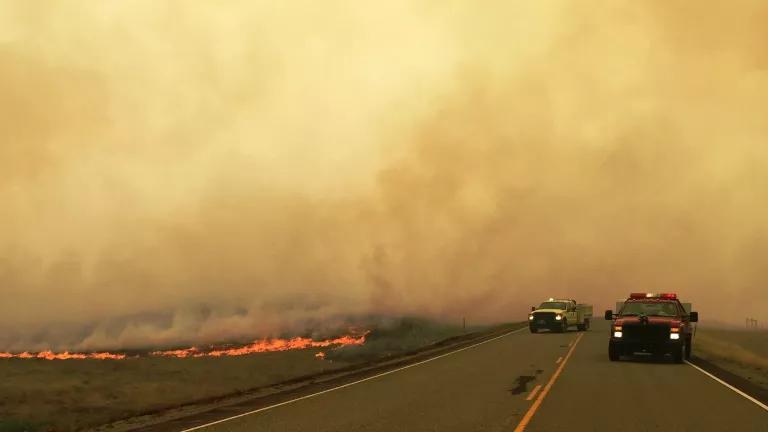NRDC's Approach: Reduction First and Carbon Offsets Second
While NRDC continues to make progress towards their sustainability goals they purchase carbon offsets and Water Restoration Certificates® using strict criteria.

Table 1. NRDC's sustainability journey in metrics
Individual impact on climate change is hard to grasp. However, a study found that one tonne of carbon dioxide equivalent (CO2e) shrinks the Arctic ice cover by 32 square feet. This means a commercial jet's round trip flight from Los Angeles to London melts over 13,000 square feet of ice. Before your company runs out to purchase carbon offsets it important to first begin implementing strategies to integrate sustainability and reduce or eliminate the activities causing greenhouse gas (GHG) emissions. At our organization we evaluate items like water and energy use, waste generation, and staff business travel. Our findings are reflected in our Sustainable Operations Plan and institutional policies that provide guidance on topics like zero waste, responsible catering, and travel.
While our organization progresses (Table 1) toward our sustainability goals—documented thoroughly in the NRDC Environmental Footprint—we continue to support positive mitigation measures to help counterbalance our direct and indirect negative environmental impacts. We support this through purchasing carbon offsets and Water Restoration Certificates® (WRCs) that align with the NRDC Environmental Offset Policy.
Calculating Our Environmental Footprint
The annual NRDC Environmental Footprint spans across all NRDC staff members and offices—New York City, NY; Washington, D.C.; Chicago, IL; Los Angeles, CA; San Francisco, CA; Bozeman, MT; and Beijing, China. It is an incredibly comprehensive document that illustrates trends, opportunities for improvement, and the amount of gallons of water and tonnes of CO2e that need offsetting as a result of our office operations and movement around the world. The scope of these calculations encompass:
- Water usage in our office buildings.
- Scope 1, 2, & 3 GHG emissions from:
- Waste generation and disposal.
- Heat and electricity use.
- Business travel—rail, car, and air—and commuter travel.
- Printing, binding, and mailing.
- Select events and hotel stays.
- Online advertising.
- Data storage.
- Embodied carbon from construction and fuel.
The Footprint's results help guide our carbon offset and WRCs purchases. We aspire to have these purchases be well-implemented and effectively managed to ensure it supports a secure water future, reduces GHG emissions, and/or increases carbon sequestration while providing additional benefits beyond environmental mitigation. They are not the solution to climate change, but rather one mechanism that can support our transition to a sustainable future.
Water Restoration Certificates® Criteria
We purchase WRCs through the Bonneville Environmental Foundation (BEF) that directly supports the restoration of natural water systems. Their portfolio of water restoration projects promote biodiversity, healthy plants, biological communities, water storage, and infiltration in wetlands and watersheds across the United States. All these projects are third-party verified by the National Fish & Wildlife Foundation and LimnoTech to ensure that the projects occur and provide the most environmental and water benefits.

This project located in Camp Verde, AZ will replace inefficient flood irrigation systems with modernized drip irrigation.
NRDC Carbon Offset Criteria
The carbon offsets that our organization purchases fund projects that reduce GHG emissions to help compensate for the ones generated by our operations and travel. For a project to be selected it must meet strict criteria:
- Additionality. The emissions reduction activity would not have occurred in the absence of our purchase. For example, the purchase of a carbon offset could serve as an incentive for a landowner to not cut down trees on their land. However, if the landowner had no intention to cut down their trees in the first place, then the offset does not provide additionality.
- Co-benefits. The project has other environmental benefits besides climate mitigation. For example, an offset that helps preserve a forest limits GHG emissions and protects the biodiversity of that ecosystem.
- Context. The environmental, social, and political circumstances in which offset projects occur is evaluated to ensure true additionality and leakage prevention.
- Location. We seek out communities that are significantly and disproportionately impacted by GHG emissions and/or the climate crisis, and give special consideration to community projects located near our office locations. We respect the Free Prior Informed consent which protects development of indigenous peoples’ land and natural resources.
- Project Verification. The emissions reduction must be verified to ensure that 1 Verified Emissions Reduction is equivalent to 1 tonne of CO2e. We also purchase through the Green e-Climate program—verified by non-profit organizations such as the Climate Action Reserve or Verra—so that the projects support additionality and result in real, enforceable, and permanent reductions.
To better understand which projects meet this criteria, among other resources, we reference the Oko-Institut e.V study (detailed in Table 2).

Table 2. Select takeaways from the Oko-Institut e.V study published by the EU
Move Forward with Intention
Have you calculated your carbon footprint yet? Use your results as a starting point for improvement. There are easy changes you can adopt today to reduce your footprint. As you progress closer toward achieving your sustainability goals don’t forget to check out sites like Green-e or Gold Standard to find reputable projects to support—carbon offsets typically cost $10 to $20 per tonne of CO2e.
If you would like more information on how we calculate the NRDC Environmental Footprint or our sustainable operations please email sustainability@nrdc.org.



